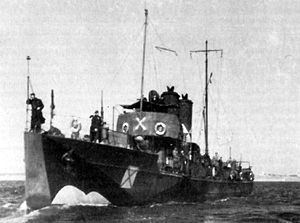Name Tb 83 F Laid down 1913 Name Smeul Launched 1888 Range 2.2224 million m | Builder Ganz & Danubius Commissioned 1915 Construction started 1887 Length 59 m | |
 | ||
Fate Given to Romania as reparations, 1920 | ||
NMS Smeul was a torpedo boat of the Royal Romanian Navy which entered service in 1920. The ship initially served as Tb 83 F in the Austro-Hungarian Navy during World War I and was awarded to Romania as reparations after the war ended.
Contents
Construction and career
A ship of the Năluca class, she displaced 266 tons and was initially armed with two 66 mm naval guns and four 450 mm torpedo tubes. In 1939, one of her 66 mm guns was replaced by a 37 mm anti-aircraft gun and a further 20 mm anti-aircraft gun was also added. During World War II, she and her sister ship Năluca were rearmed with two 88 mm naval guns and two 20 mm anti-aircraft guns. Năluca was sunk by Soviet aircraft on 20 August 1944, but Smeul survived and after the 23 August 1944 coup, she was commissioned by the Soviet Navy as Toros. In October 1945, she was returned to Romania. After being refitted at the Galați shipyard, she was recommissioned in 1946 and finally broken up in 1960.
While fighting on the Axis side during World War II, she was involved in the minelaying operation of the Bulgarian coast in October 1941 and escorted the Romanian minelayers Amiral Murgescu and Dacia when they laid mines near Odessa in June 1942. In May 1944, she helped evacuate German and Romanian troops from the Crimea. Her sister ship Năluca, aided by the motor torpedo boats Viscolul and Vijelia, sank the Soviet submarine Shch-206 on 9 July 1941.
World War I counterpart
NMS Smeul was initially the name of a much smaller torpedo boat, part of a class of three, commissioned by the Romanian Navy in 1888. She was built in France, measuring 36.78 meters in length, displacing 56 tons, with a top speed of 20 knots and a crew of 20. Armament consisted of two five-barrelled 37 mm Hotchkiss anti-aircraft guns and two 356 mm torpedo tubes. In 1907, she was rebuilt and modified, her boilers and chimneys being reduced from two to one. On 30 September 1916, she was attacked by the German submarine UB-42, but she managed to repel the attack damaging the submarine in the process. She capsized and sank in April 1917.
